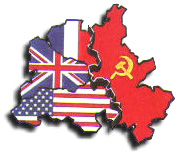|
|
|
Shortly after my rescue from Fais Island on November 13, 1948, I was assigned to another B-29 aircraft and crew in the 98th bomb group while stationed at Spokane AFB. Times in the military ran smoothly for a while, but because of problems mounting in Germany we were sent to England.
Sculthorpe Air Base, England
The Soviet Union initiated what was known as the Berlin blockade in June, 1948. The Soviets cut off entry to Berlin from the West, hoping to prevent the U.S., France, and Britain from creating an independent West Germany. The United States then counteracted the blockade of the Soviet Union by implementing a massive airlift to keep West Berlin citizens supplied with food, fuel, and other supplies. Our 98th bomb group was sent on temporary duty assignment to England to show a strength of force and stand ready in case Soviet actions pushed us into war. The airlift continued for over a year, until finally in May, 1949, Russia lifted the blockade due to itís ineffectiveness.
While in England, I noticed the country appeared much different than it had been during WWII. Now the lights were on at night, better transportation, more cars were on the streets, and most importantly, the pubs were open a little longer. Unfortunately, the beer was still warm. With the blockade lifted, our group was ordered to return to Spokane.
Spokane AFB, Washington
Once back in the states the B-29 aircraft, which I was becoming so accustomed to, was about to be replaced by new B-36 aircraft.
 My rank and position aboard the B-29 was Staff Sergeant (S/Sgt) - left waist gunner. Moving to the B-36 aircraft would result in a surplus of gunners, so I changed classifications and went into the weapons career field. The aircraft replacement of the B-29 to the B-36, however, never did occur.
My rank and position aboard the B-29 was Staff Sergeant (S/Sgt) - left waist gunner. Moving to the B-36 aircraft would result in a surplus of gunners, so I changed classifications and went into the weapons career field. The aircraft replacement of the B-29 to the B-36, however, never did occur.
Selfridge Field, Michigan
Because of my new classification and the outbreak of the Korean war, I was reassigned to the 56th Fighter Wing at Selfridge Field. While stationed here, the air corps came out with a new airborne radar field. It was at this time I entered the field of radar and received orders for the following training before being sent to Korea:
|
 |
Keesler Field, Mississippi (Radar maintenance training) |
 |
Lowry Air Base, Colorado (Latest airborne radar equipment training) |
 |
Nellis AFB, Nevada: (Flight line training) |
K13-Suwon, Korea
While attending radar training courses, hostilities were continuing to mount in Korea. In June, 1950, the North Korean Peopleís Army invaded South Korea, causing the U.S. to intervene and enter the war. Upon completion of my training, about a year after our U.S. intervention, I received orders to report to Korea. I had ten days to report to Camp Stoneman, California. I left my family behind in Cassville, WI, and made my trek to California.
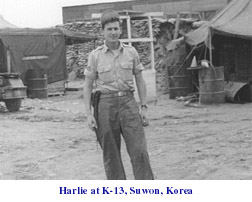 Shortly after reporting to Camp Stoneman, I was put on a troop ship for Japan. I had a short stay in Japan and was then flown to an area just outside of Seoul, Korea called Suwon. My orders were to report to K13, 8th Fighter Wing to be a member of the 35th Fighter Bomber Squadron. What a miserable, forsaken place -- tents, mud, rain, cold, and above all, the threat of the enemy. I spent 12 months in this hell hole. The constant firing of our anti-aircraft guns at enemy aircraft was the most disturbing. Almost every night small biplanes, which we called "Bed Check Charlie," would fly over our base and kick out a couple of 100 lb bombs.
They never caused much damage, however, one bomb did hit our shit house, and blew shit all over the area. While at Suwon, I was section chief of armament with the 35th.
Shortly after reporting to Camp Stoneman, I was put on a troop ship for Japan. I had a short stay in Japan and was then flown to an area just outside of Seoul, Korea called Suwon. My orders were to report to K13, 8th Fighter Wing to be a member of the 35th Fighter Bomber Squadron. What a miserable, forsaken place -- tents, mud, rain, cold, and above all, the threat of the enemy. I spent 12 months in this hell hole. The constant firing of our anti-aircraft guns at enemy aircraft was the most disturbing. Almost every night small biplanes, which we called "Bed Check Charlie," would fly over our base and kick out a couple of 100 lb bombs.
They never caused much damage, however, one bomb did hit our shit house, and blew shit all over the area. While at Suwon, I was section chief of armament with the 35th.
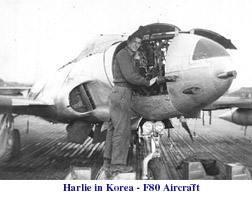 While at war with North Korea, the Chinese also entered the conflict and were threatening the use of germ warfare. In preparation for this, I was selected to attend a training course in Japan for chemical, biological, and nuclear warfare. I was dispatched to Seoul, Korea, and had to catch a plane back to Japan. As I crossed a bridge on the way to Seoul, I saw what appeared to be bodies hanging from the bridge beams. I said to the Korean jeep driver,"what the hell is that?" He replied, "People! Thatís what happens when you collaborate with the enemy." I was thankful to be an American. Once in Japan, my environment changed significantly. I was living in a hotel, eating like a king, and taking a bath or shower whenever I liked. Some difference from the hell hole I had just left, where I slept in Quonset huts, ate out of a mess kit, and took a bath in my helmet.
While at war with North Korea, the Chinese also entered the conflict and were threatening the use of germ warfare. In preparation for this, I was selected to attend a training course in Japan for chemical, biological, and nuclear warfare. I was dispatched to Seoul, Korea, and had to catch a plane back to Japan. As I crossed a bridge on the way to Seoul, I saw what appeared to be bodies hanging from the bridge beams. I said to the Korean jeep driver,"what the hell is that?" He replied, "People! Thatís what happens when you collaborate with the enemy." I was thankful to be an American. Once in Japan, my environment changed significantly. I was living in a hotel, eating like a king, and taking a bath or shower whenever I liked. Some difference from the hell hole I had just left, where I slept in Quonset huts, ate out of a mess kit, and took a bath in my helmet.
 Unfortunately, the six week training course came to an end, and I was sent back to Suwan, Korea and finished out my tour.
My new duties and training resulted in my promotion to Technical Sergeant (T/Sgt).
Unfortunately, the six week training course came to an end, and I was sent back to Suwan, Korea and finished out my tour.
My new duties and training resulted in my promotion to Technical Sergeant (T/Sgt).
My assignment in Korea finally came to an end, and I received orders to return to the United States. I was flown to Japan and put on a troop ship for San Francisco. I'll never forget how happy I was to see the beautiful Golden Gate Bridge again as we arrived. I recalled the awful feeling when leaving the U.S. for Korea, wondering if Iíd ever see the bridge again.
In the years following, I continued to uproot my family because the airforce sent me on various assignments throughout the United States. The following were my assignments:
Truax Field, Wisconsin
I was assigned to 343rd Fighter Squadron. While at Truax, my squadron was sent to Yuma, AZ, for six weeks of air-to-air gunnery training.
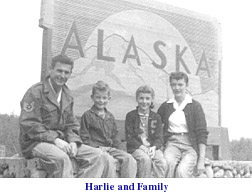 Ladd AFB, Alaska
Ladd AFB, Alaska
June 1954, our 343rd squadron was transferred to Alaska. Off my family and I went with a new 1954, three quarter ton truck and trailer, up the Alcan highway to Alaska. I had eight flat tires on the truck and three on the trailer house during the trip. We were in convoy with other military families who had just as many problems. It took us 22 days to get from Madison to Fairbanks.
Lowry AFB, Colorado
January, 1956, during the dead of winter, we left Fairbanks and returned to the U.S. My duties were as an airborne radar instructor. While at Lowry, I attended Lockheed Factory School -- Burbank, CA, for training on F-104 aircraft.
Chanute AFB, Illinois
This was a temporary re-assignment for air training command.
 Wright Patterson AFB, Ohio
Wright Patterson AFB, Ohio
I was assigned to the Field Training Detachment as an airborne radar instructor on F-104 aircraft.
While on this assignment:
|
 |
Promoted to Master Sergeant (M/Sgt).
|
 |
Awarded instructor of the month for all field training detachments. |
 |
Republic Aircraft School, Farmingdale, NY: (F-105 aircraft training) |
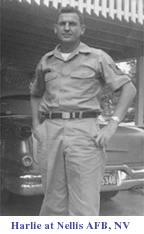 Nellis AFB, Nevada
Nellis AFB, Nevada
I was assigned to the Field Training Detachment as the radar instructor on F-105 aircraft. My commander on this assignment was Captain Michael Collins. Later, Michael Collins would become one of three astronauts on board the first spacecraft to the moon. He would fly the module around the moon as Armstrong, and Adrian landed on the moon in 1969.
Ramstein Air Base, Germany
In 1961, I was sent to Germany on temporary duty assignment and assigned to a F-105 Mobile Training Detachment. I flew to Republic Aircraft School, Farmingdale, NY, where I picked up our F-105 aircraft equipment and proceeded to Germany. I was to instruct personnel on F-105 radar. My first assignment was at Ramstein Air Base, Germany, and then to Spangdahlem Air Base, Germany.
Spangdahlem Air Base, Germany
These were turbulent times in Germany as the battle lines of the cold war between the western allies and the Soviet Union had been drawn. On August 27, 1961, the Berlin wall was constructed and tensions were high on both sides of the wall. On October 27, 1961, ten Soviet tanks and ten U.S. tanks squared off against one another at "Checkpoint Charlie" which was a checkpoint in Berlin. The group we were supporting went on immediate 24 hour alert. Their planes were loaded with bombs and the pilots were in their cockpits ready to go should this stand-off escalate into something more than a test of nerves. Fortunately, about 16 hours later, under orders from Moscow, the soviet tanks retreated and the confrontation ended. This whole ordeal seemed so ironic! During WWII, I was bombing Germany who at that time was our enemy, and now we were defending them against our former allied Russia. Oh, how the world turns!
Nellis AFB, Nevada
After a year in Germany, I was transferred back to the U.S. to resume my F-105 training.

Amarillo AB, Texas
In late 1962, I was transferred to Air Force headquarters. There were two memorable events on this assignment:
|
 |
Promoted to Senior Master Sergeant (SM/Sgt). |
 |
March 17, 1963 - My daughter Sue married Francis William Keck at the Amarillo Base Chapel. |
Kincheloe AFB, Michigan
In July 1963, I received a detachment commanderís position. Kincheloe AFB is located in the upper Peninsula of Michigan. I was the Commander of the 226A Field Training Detachment, which consisted of approximately 20 instructor personnel, all non-commissioned officers. Our mission was to train personnel on the F-106 aircraft. Kincheloe was a great assignment which consisted of a 40 hour work week, leaving plenty of time for hunting, fishing, boating, and parties. In my opinion this was one of the best fishing and hunting areas in the U.S.
 Unfortunately, this assignment came to an end in late 1969, when the F-106 was phased out and our detachment was closed down.
Also during this assignment:
Unfortunately, this assignment came to an end in late 1969, when the F-106 was phased out and our detachment was closed down.
Also during this assignment:
 |
Promoted to Chief Master Sergeant (CM/Sgt). |
Nellis AFB, Nevada
My next assignment was NCO in charge of the Avionics section. This section consisted of approximately 120 airman, most of them on their first hitch.
During this assignment I ran into some aspects of service life that I had not previously been exposed. Morale was the lowest I had ever seen. Some personnel were using drugs, and others were living off base -- losing their money in casinos. Discipline and pride in the military as I had known it was changing and becoming a thing of the past.
On September 30, 1970, after 26 years of an extremely fulfilling and eventful career, I retired from military life as a Chief Master Sergeant.
I had started my military career in 1942, and served my country during WWII campaign and also saw action during the Korean campaign. It was now time to try my hand at civilian life again.
|
|
